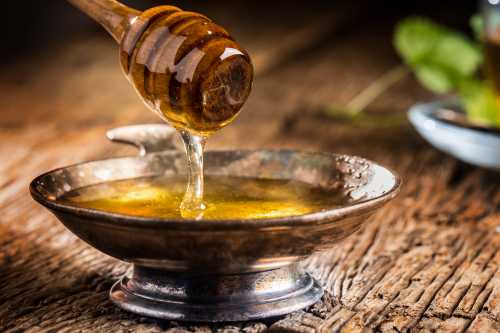Borage Honey
Borage honey is made from nectar gathered by honey bees (Apis mellifera) from the lovely blue flowers of the borage plant, Borago officinalis.
It should not be confused with 'Blue Borage Honey' which is honey made from nectar gathered from the flowers of a different, but related plant species, viper's bugloss (Echium vulgare).
What's So Special About Borage Honey?
Borage is a bushy herb plant.
Borage honey is a monofloral (or unifloral) honey with a delicate flavour. It is pale golden in colour, runny and is slow to granulate1.
To make it, beekeepers take their beehives to borage fields, where their bees can gather the rich abundance of nectar secreted by the many flowers gracing each plant. Elsewhere on this site, I have written in greater detail about the value of borage for bees and pollinators.
 Honey bee Apis mellifera foraging on a borage flower.
Honey bee Apis mellifera foraging on a borage flower.What is borage honey good for?
There is much research available regarding the borage plant (also called 'starflower'). It is a plant with known culinary and medicinal value, and is used in herbal preparations and supplements.
Whether or not any of the health giving benefits are transferred from plant to honey is unclear, since at the time of writing, I am currently unaware of any specific analysis of the chemical properties of borage honey.
However, it is known that medicinal or therapeutic qualities of some other plants can indeed transfer from flower to honey, as is the case with Manuka honey and its proven efficacy against MRSA, for example.
So what do we know about the borage plant, Borago officinalis?
Efficacy of borage against symptoms of asthma, including cough
A randomized, double-blind, placebo-controlled, clinical trial2 found that 'Borago extract' (at a dose of 5 ml three times a day) significantly reduced cough, dyspnea, wheezing, nocturnal symptoms, and airway hyper-responsiveness in comparison with the control group.
Honey is useful for cough as a known anti-tussive (cough suppressant) so we might reasonably ponder whether borage honey is particularly effective against cough, in comparison with other honey varieties.
Borage seed oil
Borage seed oil is sold for a variety of purposes, including for use as a facial oil. Oil extracted from borage seeds is the richest known source of gamma-linolenic acid (GLA)3. Studies suggest efficacy of GLA as an anti-inflammatory4 and against conditions such as rheumatoid arthritis5.
Again, I should stress that the specific properties of borage honey are yet to be confirmed as far as I am aware (at the time of writing this article), and so the relevance of the above specifically to borage honey is as yet, unknown.
English borage honey
In the UK, English borage honey is a popular, mid-premium honey. Beekeepers take their hives to borage fields so that their bees can forage on the crop.
Below are links to several suggested sellers. Please note that I do not receive commissions or payments from any of these companies, nor do I have any relationship with the owners.
The suppliers in the list below are genuine online sellers of English borage honey as far as I can see. I am sure there are more suppliers, but I have listed only three.
Hoyle's English Borage Honey
From a family farm where the bees are able to forage on a crop of borage. Winner of 2 gold stars awarded for great taste.
Happy Valley English Borage Honey
Set in the Peak District, the beekeepers preserve the distinct properties and complex flavours of this honey, by doing as little to it as possible.
Littleover Apiaries
Made from nectar gathered from borage fields of the rural eastern counties of England.
If conducting your own search for a supplier of English borage honey, I recommend choosing a seller that provides plenty of specific information about themselves and their business.
References
1. Stawiarz, Ernest, Wróblewska, Anna, Masierowska, Marzena and Sadowska, Dagmara. "Flowering, Forage Value, and Insect Pollination in Borage (Borago Officinalis L.) Cultivated in Se Poland" Journal of Apicultural Science, vol.64, no.1, 2020, pp.77-89. https://doi.org/10.2478/jas-2020-0005.
2. Mirsadraee M, Khashkhashi Moghaddam S, Saeedi P, Ghaffari S. Effect of Borago Officinalis Extract on Moderate Persistent Asthma: A Phase two Randomized, Double Blind, Placebo-Controlled Clinical Trial. Tanaffos. 2016;15(3):168-174.
3. Plant 246 Borago officinalis L. (Boraginaceae), Oxford University.
4. Kapoor R, et al. Gamma Linolenic Acid: An anti-inflammatory omega-6 fatty acid (Review) Curr Pharm Biotech 7:531-34, 2006.
5. Zurier RB, et al. Gamma-linolenic acid treatment of rheumatoid arthritis. A randomized, placebo-controlled trial. Arthritis Rheum39:1808-17, 1996.
Did You Know?
Toxic Honey Was Used In Ancient Warfare!





